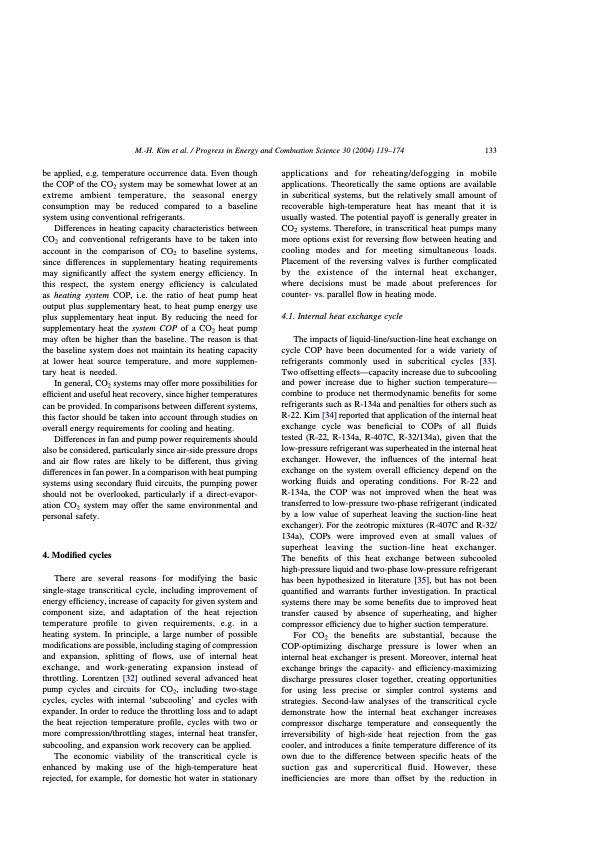
PDF Publication Title:
Text from PDF Page: 015
M.-H. Kim et al. / Progress in Energy and Combustion Science 30 (2004) 119–174 133 be applied, e.g. temperature occurrence data. Even though the COP of the CO2 system may be somewhat lower at an extreme ambient temperature, the seasonal energy consumption may be reduced compared to a baseline system using conventional refrigerants. Differences in heating capacity characteristics between CO2 and conventional refrigerants have to be taken into account in the comparison of CO2 to baseline systems, since differences in supplementary heating requirements may significantly affect the system energy efficiency. In this respect, the system energy efficiency is calculated as heating system COP, i.e. the ratio of heat pump heat output plus supplementary heat, to heat pump energy use plus supplementary heat input. By reducing the need for supplementary heat the system COP of a CO2 heat pump may often be higher than the baseline. The reason is that the baseline system does not maintain its heating capacity at lower heat source temperature, and more supplemen- tary heat is needed. In general, CO2 systems may offer more possibilities for efficient and useful heat recovery, since higher temperatures can be provided. In comparisons between different systems, this factor should be taken into account through studies on overall energy requirements for cooling and heating. Differences in fan and pump power requirements should also be considered, particularly since air-side pressure drops and air flow rates are likely to be different, thus giving differences in fan power. In a comparison with heat pumping systems using secondary fluid circuits, the pumping power should not be overlooked, particularly if a direct-evapor- ation CO2 system may offer the same environmental and personal safety. 4. Modified cycles There are several reasons for modifying the basic single-stage transcritical cycle, including improvement of energy efficiency, increase of capacity for given system and component size, and adaptation of the heat rejection temperature profile to given requirements, e.g. in a heating system. In principle, a large number of possible modifications are possible, including staging of compression and expansion, splitting of flows, use of internal heat exchange, and work-generating expansion instead of throttling. Lorentzen [32] outlined several advanced heat pump cycles and circuits for CO2, including two-stage cycles, cycles with internal ‘subcooling’ and cycles with expander. In order to reduce the throttling loss and to adapt the heat rejection temperature profile, cycles with two or more compression/throttling stages, internal heat transfer, subcooling, and expansion work recovery can be applied. The economic viability of the transcritical cycle is enhanced by making use of the high-temperature heat rejected, for example, for domestic hot water in stationary applications and for reheating/defogging in mobile applications. Theoretically the same options are available in subcritical systems, but the relatively small amount of recoverable high-temperature heat has meant that it is usually wasted. The potential payoff is generally greater in CO2 systems. Therefore, in transcritical heat pumps many more options exist for reversing flow between heating and cooling modes and for meeting simultaneous loads. Placement of the reversing valves is further complicated by the existence of the internal heat exchanger, where decisions must be made about preferences for counter- vs. parallel flow in heating mode. 4.1. Internal heat exchange cycle The impacts of liquid-line/suction-line heat exchange on cycle COP have been documented for a wide variety of refrigerants commonly used in subcritical cycles [33]. Two offsetting effects—capacity increase due to subcooling and power increase due to higher suction temperature— combine to produce net thermodynamic benefits for some refrigerants such as R-134a and penalties for others such as R-22. Kim [34] reported that application of the internal heat exchange cycle was beneficial to COPs of all fluids tested (R-22, R-134a, R-407C, R-32/134a), given that the low-pressure refrigerant was superheated in the internal heat exchanger. However, the influences of the internal heat exchange on the system overall efficiency depend on the working fluids and operating conditions. For R-22 and R-134a, the COP was not improved when the heat was transferred to low-pressure two-phase refrigerant (indicated by a low value of superheat leaving the suction-line heat exchanger). For the zeotropic mixtures (R-407C and R-32/ 134a), COPs were improved even at small values of superheat leaving the suction-line heat exchanger. The benefits of this heat exchange between subcooled high-pressure liquid and two-phase low-pressure refrigerant has been hypothesized in literature [35], but has not been quantified and warrants further investigation. In practical systems there may be some benefits due to improved heat transfer caused by absence of superheating, and higher compressor efficiency due to higher suction temperature. For CO2 the benefits are substantial, because the COP-optimizing discharge pressure is lower when an internal heat exchanger is present. Moreover, internal heat exchange brings the capacity- and efficiency-maximizing discharge pressures closer together, creating opportunities for using less precise or simpler control systems and strategies. Second-law analyses of the transcritical cycle demonstrate how the internal heat exchanger increases compressor discharge temperature and consequently the irreversibility of high-side heat rejection from the gas cooler, and introduces a finite temperature difference of its own due to the difference between specific heats of the suction gas and supercritical fluid. However, these inefficiencies are more than offset by the reduction inPDF Image | CO2 Vapor Compression Systems

PDF Search Title:
CO2 Vapor Compression SystemsOriginal File Name Searched:
co2-vapor-compression-systems.pdfDIY PDF Search: Google It | Yahoo | Bing
CO2 Organic Rankine Cycle Experimenter Platform The supercritical CO2 phase change system is both a heat pump and organic rankine cycle which can be used for those purposes and as a supercritical extractor for advanced subcritical and supercritical extraction technology. Uses include producing nanoparticles, precious metal CO2 extraction, lithium battery recycling, and other applications... More Info
Heat Pumps CO2 ORC Heat Pump System Platform More Info
| CONTACT TEL: 608-238-6001 Email: greg@infinityturbine.com | RSS | AMP |